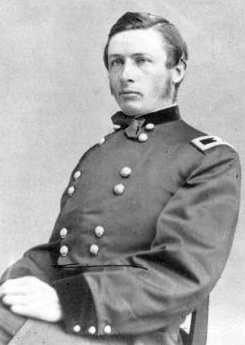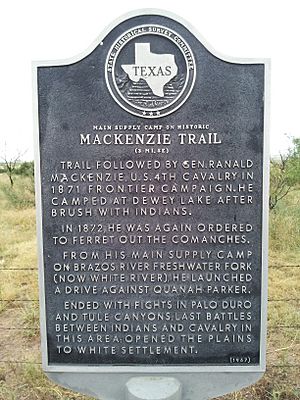Ranald S. Mackenzie facts for kids
Quick facts for kids
Ranald Slidell Mackenzie
|
|
|---|---|

Ranald S. Mackenzie
|
|
| Nickname(s) | "Bad Hand", "No-Finger Chief" |
| Born | July 27, 1840 Westchester County, New York |
| Died | January 19, 1889 (aged 48) Staten Island, New York |
| Place of burial |
West Point Cemetery
|
| Allegiance | United States of America Union |
| Service/ |
United States Army Union Army |
| Years of service | 1862–1884 |
| Rank | |
| Commands held | 2nd Connecticut Heavy Artillery 41st U.S. Infantry 24th U.S. Infantry 4th U.S. Cavalry |
| Battles/wars | American Civil War |
| Relations | John Slidell (uncle) Alexander Slidell Mackenzie (father) Alexander Slidell MacKenzie (brother) |
Ranald Slidell Mackenzie (July 27, 1840 – January 19, 1889) was an important officer in the United States Army. He fought bravely in the American Civil War for the Union Army. Later, he also served with great skill in the American Indian Wars. General Ulysses S. Grant once called him the most promising young officer in the army. People sometimes called him Bad Hand because of an injury he got in battle.
Contents
Early Life and School Days
Ranald Mackenzie was born in Westchester County, New York. His father, Alexander Slidell Mackenzie, was a high-ranking officer in the Navy. Ranald also had two brothers who became Navy officers. His uncle, John Slidell, was a well-known politician.
Ranald first went to Williams College. Then, he was accepted into the United States Military Academy at West Point. He was a brilliant student and graduated at the very top of his class in 1862. Right after graduating, he joined the Union forces fighting in the Civil War.
Fighting in the Civil War
Ranald Mackenzie started his military career as a Second Lieutenant in the Army's engineering group. He fought in many major battles of the Civil War. These included the Second Battle of Bull Run, Battle of Antietam, and Battle of Gettysburg. He also took part in the Overland Campaign and the Siege of Petersburg in 1864.
He was wounded several times during these battles. At the siege of Petersburg, he was shot in his right hand. This injury caused him to lose two fingers. This is likely how he got his nickname, "Bad Hand." By June 1864, his bravery had earned him a promotion to lieutenant colonel.
In July 1864, he became a Colonel and led the 2nd Connecticut Heavy Artillery. He moved with his troops to stop a raid on Washington. He was wounded again in another battle. After he recovered, he was given command of a brigade. He was wounded one more time at the Battle of Cedar Creek.
On November 30, 1864, President Abraham Lincoln made Mackenzie a Brigadier general. He then led the Cavalry Division in the Army of the James. He played a key role in the final battles of the war, including Battle of Five Forks and Battle of Appomattox Court House. This is where the main Confederate army surrendered.
General Ulysses S. Grant praised Mackenzie highly. Grant wrote that Mackenzie was "the most promising young officer in the army." He noted that Mackenzie rose quickly through the ranks because of his own skills. Mackenzie was wounded six times and received many honors for his bravery. He was known for being very strict with his soldiers. They sometimes called him the "Perpetual Punisher." However, other officers respected his abilities greatly.
Service in the Indian Wars
After the Civil War ended, Mackenzie stayed in the regular army. He was made a colonel of the 41st U.S. Infantry in 1867. This was one of the Buffalo Soldier regiments, made up of African-American soldiers. Mackenzie did a good job leading this regiment.
In 1871, he took command of the 4th U.S. Cavalry in Texas. He led his regiment in battles against Native American tribes. He was wounded a seventh time by an arrow in his leg in October 1871. He also led a raid into Mexico to stop Native American groups from using it as a safe place.
Mackenzie played a big part in the Red River War. He led his troops to victory at the Battle of Palo Duro Canyon. In 1876, he defeated the Cheyenne in the Dull Knife Fight. This battle helped bring an end to the Great Sioux War of 1876.
In 1881, he became the commander of the District of New Mexico. In 1882, he was promoted to brigadier general. He was assigned to the Department of Texas in 1883. Mackenzie bought a ranch in Texas and planned to get married. However, he started acting strangely. This was thought to be because of a head injury he got from a fall. Because of his changing behavior, he retired from the Army in 1884.
Ranald Mackenzie passed away at his sister's home in Staten Island, New York. He is buried in West Point National Cemetery.
Memorials and Legacy
Many places and things are named after General Ranald S. Mackenzie:
- Fort Mackenzie in Sheridan, Wyoming, was a military post. Today, it is a hospital for veterans.
- Fort Mackenzie High School in Sheridan is an alternative school.
- Mackenzie Road is a main road at the Fort Sill training area.
- Forward Operating Base MacKenzie was a military base in Iraq.
- Mackenzie Park in Lubbock, Texas, is a large park.
- Mackenzie Middle School is also in Lubbock, Texas.
- Lake Mackenzie in Tule Canyon, Texas, is a lake named in his honor.


